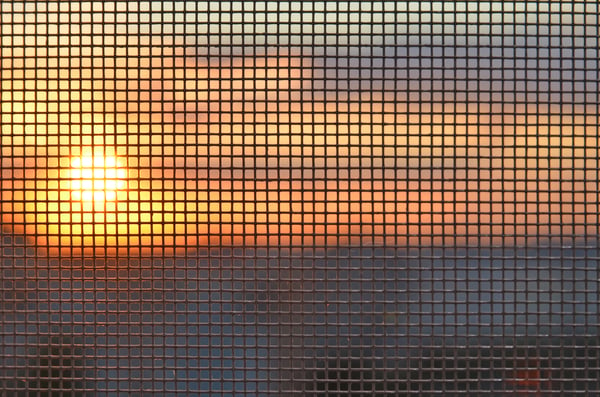Consider these scenarios:
- It’s hot and you don’t have air conditioning in your home or business.
- You’ve accidentally burned tonight’s dinner on the stove. It’s still smoking.
- You’re trying to relax and the sounds of nature would help calm your nerves.
What’s the first thing you’ll likely do?
Probably open a window.
But insects, birds, leaves, and other airborne nuisances that get inside through your window can quickly make you regret opening it in the first place.
Designed to keep elements of the great outdoors in their natural habitat without obstructing airflow, window screens create a barrier between the inside of a building and what’s outside.
But wire mesh screens do more than keep bugs out and let air in -- they contribute significantly to a residential or commercial property’s aesthetic appeal. A building appears more finished when its windows have screens.
Choosing a window screen isn’t a matter of selecting a mesh that looks good. There are two key factors that let you get the desired performance from a screen: screen mesh sizes and materials.
What to Consider When Shopping for Wire Mesh Screens
Selecting the right screen for a specific application takes a few factors into consideration:
- Screen mesh sizes and strand size: How big is whatever you want to keep out? And how wide a span do you want the screen to cover?
- Material: Which material best suits the screen’s purpose, environment, and desired aesthetic?
Unsure which window screen is right for your project?
Compare our available window screen mesh inventory:
Screen Wire Size: What Are Mesh Size and Strand Size?
Put simply, mesh size is a measurement of the holes in the screen. The size of the holes determines what gets through and what doesn’t. Window screen mesh hole size also influences the screen’s rigidity.
Strand size -- or gauge -- measures the diameter of each “wire” that makes up the screen. Thicker wire diameters add to the screen strength but can take away from its good looks and outward visibility.
Combined with a larger strand size, a window screen with a smaller mesh size will have more integrity and be able to span wider distances without sagging.
How to Measure Screen Mesh Sizes
Measuring mesh size is a matter of finding the number of “holes” in a square inch of screen.
You can find this number by cutting a 1-inch by 1-inch hole in the middle of a piece of paper. Then:
- Tape the paper to the screen so the edges of the cutout line up with the vertical and horizontal wires in the screen.
- Count the holes in the mesh horizontally from one side of the cutout to the other. Write this number down.
- Count the holes from the top of the cutout to the bottom. Write it down.
- You now have the mesh size, which you’ll write as (number of horizontal holes) x (number of vertical holes). Don’t be surprised if the answer is 18 x 16, 18 x 14, or 20 x 20.
Window wire mesh size matters to most screens’ principal purpose: keeping bugs out while letting air flow freely into an area. In some parts of the country (and the world), tiny flying insects (often called no-see-ums) are prevalent.
A mesh size of 18x14 or even 18x16 might not keep these menaces out. But a 20x20 mesh screen would. On the other hand, the tighter mesh also slightly reduces airflow.
What Materials Are Used to Make Screens?
As screens meet many demands, there are multiple materials from which to choose.
Window mesh screen material type plays a significant role in a screen’s performance. Some materials are designed for durability and longevity, while others strictly serve a functional purpose: allowing air circulation.
Popular screen products used in the residential and commercial sectors include:
- Black PetScreen® -- A pet screen mesh, this Phifer product provides an insect screen with the ability to resist damage from pets. It’s made of vinyl-coated polyester.
- Brite-Kote™ Bright Aluminum Screen -- For good air ventilation and aesthetics, this aluminum mesh screen also offers durability.
- Charcoal fiberglass screen -- Providing good visibility through the screen to the outside, fiberglass screen mesh also won’t rust, corrode or stain.
- Charcoal aluminum screen -- Another metal screen mesh material, the charcoal aluminum screen offers reduced glare, good outward visibility, and a weather-resistant finish.
- SeeVue insect screen -- SeeVue is a stainless steel wire mesh screen that boasts a black finish and durability.
- UltraVue insect screen -- Featuring excellent visibility and lasting protection, UltraVue is a fiberglass screen mesh with a vinyl coating.
Screens are also made of copper, brass, and other materials -- the choices are pretty broad to meet a variety of applications.
Window Screen Performance = Screen Mesh Sizes + Wire Gauge + Material
A natural part of any window, carefully selecting mesh screens helps maximize a window’s functionality. Combining the right screen mesh size, wire gauge, and material type lets you wholly enjoy an open window.
Looking for a glass partner for your next commercial project? Check out our services and capabilities:
(Editor's note: This blog was originally published in May 2019 and was recently updated).





